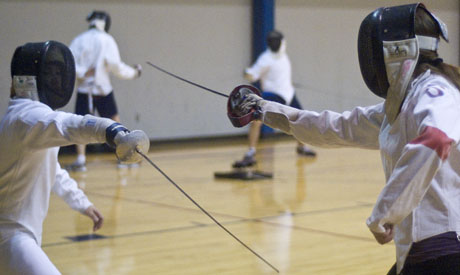Saint Louis University has over 100 organizations that appeal to a diverse student body and reach out to enrich each individual’s experience at SLU. The Fencing Club is among these organizations, and it seeks to revitalize a student’s mind and body.
 “Fencing started at SLU way back in 1941 and closed down when the war started. It recently reopened in 1999 as a fencing society, and we became the wonderful theatrical people that you see on TV,” Fencing Club President Tran Nguyen said.
“Fencing started at SLU way back in 1941 and closed down when the war started. It recently reopened in 1999 as a fencing society, and we became the wonderful theatrical people that you see on TV,” Fencing Club President Tran Nguyen said.
Nguyen and a friend opened up the group last year to be competitive and initially only had four members.
“We recruit these fencers by word of mouth or by randomly asking people if they want to join, since not many people know about the sport. Also, since we [are not funded by Student Government Association], we allow our coach Bruce [Sikes] to bring in a certain amount of outside people, and they pay for his salary,” Nguyen said. “These people only practice with us, but they don’t get to compete for the SLU team.”
Fencing Club has a core team made up of two SLU faculty members, three SLU alumni, seven SLU students and three students from Washington University in St. Louis.
During practice, Fencing Club does a variety of things, usually depending upon if a competition is coming up.
“In the beginner class, we show them the fundamentals, such as blade work, and everyone starts off on the same slate. After this, if people stay, we then would develop each person individually,” Nguyen said. “Every person would have a different style and technique, different strong and weak points.”
Outside of the beginner class, the club has a competitive team that competes at Northwestern University, University of Missouri in Columbia and the St. Louis divisional and sectional. To train for competitions, Sikes advises students as they fence each other one on one. Usually, inexperienced fencers fence experienced ones; this way, a lot is learned from these matches.
Fencing is a sport that has three major weapons: foil, sabre and épée. A foil is a light thrusting weapon, and is used to target the torso, the chest, the shoulders and the back. An épée is a heavy thrusting weapon, and the valid target area covers the entire body. A sabre is a light cutting and thrusting weapon, and that is used to target the saddle line, which is from one side of the fencer’s hip to the other, and up.
SLU Fencing Club’s weapons have rubber protective coverings or blunt ends. Each person also wears a conductive jacket, which is hooked into a machine that completes a circuit – this keeps track of whoever touches the other person, and scores it accordingly.
The game is based on a score system and can be played out in two ways: with a score system of first to 45, or an elimination system with first to five touches.
Christopher Brunett, a member of SLU’s Fencing Club, thinks this club is a great idea.
“I am a history minor, and I have a passion for classical warfare. I’ve always been interested to see how it would be like to actually fight with swords, so I just joined this semester and I love fencing,” Brunett said. “It is an excellent workout, mentally and physically, and I am getting a sense of history.”
To develop the team, access more facilities and recruit more people, Sikes has been working reach out to the students.
“I love fencing since it brings every ingredient of what you want into a sport or physical activity. It’s extremely aerobic, yet it also requires mental discipline – it’s like physical chess,” Sikes said. “I just want the students to love it as much as I do.”










